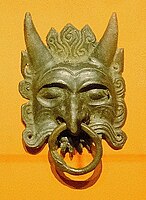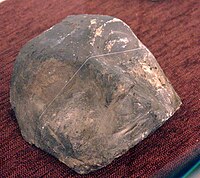Tashtyk culture


SATRAPS
PARTHIANS
culture
EMPIRE
EMPIRE
EMPIRE
HANAS
DYNASTY
The Tashtyk culture[a] was a Late Iron Age archaeological culture that flourished in the Yenisei valley in Siberia from the 1st century CE to the 4th century CE. Located in the Minusinsk Depression, environs of modern Krasnoyarsk, eastern part of Kemerovo Oblast, it was preceded by the Tagar culture and the Tesinsky culture.[6][7]
History
The Tashtyk culture was first surveyed by the Russian archaeologist Sergei Teploukhov.[8] Teploukhov suggested that it had been initially Indo-European dominated, only to become overcome by the Yenisei Kirghiz around the 3rd century AD.[8] The Yenisei Kirghiz are often associated with the Tashtyk culture.[9]
Tashtyk settlements and hill-forts have been unearthed throughout the Yenisei region, particularly the Sayan canyon area. Their most imposing monuments were immense barrows-crypt structures; these have yielded large quantities of clay and metal vessels and ornaments. In addition, numerous petrographic carvings have been found. Some of the graves contained leather models of human bodies with their heads wrapped in tissue and brightly painted. Inside the models there were small leather bags probably symbolising the stomach and containing burned human bones. Scaled-down replicas of swords, arrows and quivers were placed nearby. The animal motifs of the Tashtyk belonged to the Scytho-Altaic style, while they were also under significant Chinese influence.[6]
During his excavations of the Oglahty cemetery south of Minusinsk, Leonid Kyzlasov discovered a number of mummies with richly decorated plaster funerary masks showing Western Eurasian features,[10] though this would not rule out some East Asian admixture, as revealed by ancient DNA (see below). There were also intact fur hats, silk clothes, and footwear (now in the Hermitage Museum, St. Petersburg).
Datation

Oglakhty is considered as "the key site of stage I of the Tashtyk culture." From the early 20th century, various dates have been proposed for the Tashtyk burials: 1st century BC-1st century CE, 1st-2nd century CE. From the 1990s, new proposals were made dating the Tashtyk burials to the 3rd–4th centuries CE. C-14 Wiggle-matching datation techniques, applied to wooden logs of tomb 4 at Oglakhty have confirmed a datation to the 3rd–4th centuries CE.[4] Other post-Xiongnu cultures, such as the Kokel Culture have also been recorded nearby.[11]
-
 Tashtyk culture mask
Tashtyk culture mask -
 Tashtyk culture pottery
Tashtyk culture pottery -
 Tashtyk culture daggers
Tashtyk culture daggers
Genetics

In 2009, a genetic study covering specimens from the Tashtyk culture was published in Human Genetics.[7] Six Tashtyk remains of 100–400 AD from Bogratsky region, Abakano-Pérévoz I, Khakassia were surveyed, of which 5 yielded genetic ancestry and pigmentation alleles.[7]
All specimens examined were determined to be female. Extractions of mtDNA from three individuals resulted in their assignment to the Western Eurasian haplogroups HV, H, and T1, while the other two carried the East Asian haplogroups haplogroup C and N9a.[7] Of the Tashtyk specimens which yielded pigmentation data, the majority (4) were predicted to have blue eyes and blond or light brown hair, including those with an Asian haplogroup. All specimens were determined to be of primarily European ancestry based on the analysis of 10 SNPs.[7]
A full genome analysis on two Tashtyk mummies revealed high genetic affinity to the Saka Tagar culture, which derives around 70% from the Sintashta culture, 5% from the Bactria–Margiana Archaeological Complex, and 25% from Ancient Northeast Asian hunter-gatherers (Baikal_EBA).[12][13]
-
 Tashtyk culture mask reconstruction
Tashtyk culture mask reconstruction -
 Tashtyk culture mask, Khakassia National Museum.
Tashtyk culture mask, Khakassia National Museum. -
 A funerary mask from Tashtyk in Moscow State Historical Museum.
A funerary mask from Tashtyk in Moscow State Historical Museum. -
 More masks in Moscow
More masks in Moscow - Later masks, dated to the 5th-6th century.
-
![Funerary masks excavated near Minusinsk, photographed in 1901.[14]](//upload.wikimedia.org/wikipedia/commons/thumb/6/69/Masks_from_near_Minusinsk_%28A_ribbon_of_iron%2C_1901%29.jpg/137px-Masks_from_near_Minusinsk_%28A_ribbon_of_iron%2C_1901%29.jpg) Funerary masks excavated near Minusinsk, photographed in 1901.[14]
Funerary masks excavated near Minusinsk, photographed in 1901.[14]
Notes
References
- ^ "Siberian Times".
- ^ Nusse, Gloria (24 September 2022). Craniofacial Anatomy and Forensic Identification. Academic Press. pp. 16–17. ISBN 978-0-12-809578-2.
- ^ Bahn, Paul G. (27 October 2020). Great Sites of the Ancient World. Frances Lincoln. pp. 176–177. ISBN 978-0-7112-5914-0.
- ^ a b Zaitseva, G. I. (2009). "Dating of the Tashtyk Cultural Remains from the Oglakhty Burial Ground (Southern Siberia)". Radiocarbon. 51 (2): 423–431. doi:10.1017/S0033822200055818. ISSN 0033-8222.
- ^ Pankova, Svetlana; Simpson, St John (1 January 2017). Scythians: warriors of ancient Siberia. British Museum. pp. 344–345.
- ^ a b "Central Asian arts: Tashtyk Tribe". Encyclopædia Britannica Online. Encyclopædia Britannica. Retrieved February 15, 2015.
- ^ a b c d e Keyser, Christine; Bouakaze, Caroline; Crubézy, Eric; Nikolaev, Valery G.; Montagnon, Daniel; Reis, Tatiana; Ludes, Bertrand (May 16, 2009). "Ancient DNA provides new insights into the history of south Siberian Kurgan people". Human Genetics. 126 (3): 395–410. doi:10.1007/s00439-009-0683-0. PMID 19449030. S2CID 21347353.
- ^ a b Grousset 1970, pp. 18–19
- ^ "Xipoliya Yanke Suo Jian Xiajiesi Monijiao" ("Siberian Rock Arts and Xiajiesi's Manicheism") 1998 Gansu Mingzu Yanjiu
- ^ Zharnikova, S. V. ARCHAIC ROOTS OF TRADITIONAL CULTURE OF THE RUSSIAN NORTH: Collection of scientific articles. WP IPGEB. p. 46.
- ^ Sadykov, Timur (2021). "The Kokel of Southern Siberia: New data on a post-Xiongnu material culture". PLOS ONE. 16 (7): e0254545. doi:10.1371/journal.pone.0254545. ISSN 1932-6203. PMC 8284818.
- ^ "First ancient DNA analysis of mummies from the post-Scythian Oglakhty cemetery in South Siberia". www.researchsquare.com. 2022-08-29. doi:10.21203/rs.3.rs-1993191/v1. Retrieved 2023-04-29.
- ^ Jeong, Choongwon; Wang, Ke; Wilkin, Shevan; Taylor, William Timothy Treal; Miller, Bryan K.; Bemmann, Jan H.; Stahl, Raphaela; Chiovelli, Chelsea; Knolle, Florian; Ulziibayar, Sodnom; Khatanbaatar, Dorjpurev; Erdenebaatar, Diimaajav; Erdenebat, Ulambayar; Ochir, Ayudai; Ankhsanaa, Ganbold (2020-11-12). "A Dynamic 6,000-Year Genetic History of Eurasia's Eastern Steppe". Cell. 183 (4): 890–904.e29. doi:10.1016/j.cell.2020.10.015. hdl:21.11116/0000-0007-77BF-D. ISSN 0092-8674.
- ^ Meakin, Annette M. B. (1901). A ribbon of iron. Westminster, A. Constable & co., ltd.; New York, E.P. Dutton & co. p. 105.
Further reading
- Christian, David. A History of Russia, Central Asia and Mongolia. Blackwell Publishers, 1999.
- Grousset, René (January 1, 1970). The Empire of the Steppes: A History of Central Asia. Rutgers University Press. ISBN 978-0813513041. Retrieved February 14, 2015.
- Leonid Kyzlasov. Tashtyk Era (Таштыкская эпоха). Moscow, 1953. Page 13.
- "Oglakhty". Great Soviet Encyclopaedia, 3rd ed. 1969-1978.
- "Tashtyk culture". Great Soviet Encyclopaedia, 3rd ed. 1969-1978.
External links
- Finds from Oglakhty in the Hermitage Museum[permanent dead link]
- The Tashtyk culture is presented in Hall 31 of the State Hermitage Museum (3D Tour).
- v
- t
- e
- Mal'ta–Buret' culture
- Yamnaya culture
- Afanasievo culture
- Sintashta culture
- Vakhsh culture
- Bactria–Margiana Archaeological Complex
- Saka
- Andronovo culture
- Tagar culture
- Uyuk culture
- Pazyryk culture
- Massagetae
- Median Empire
- Achaemenid Empire
- Macedonian Empire
- Seleucid Empire
- Greco-Bactrian Kingdom
- Guiyi Circuit
- Yuezhi
- Xiongnu
- Kushan Empire
- Kushano-Sasanians
- Kidarites
- Alchon Huns
- Hephthalites
- Tocharians
- Ustrushana
- Khuttal
- Farghana
- First Turkic Khaganate
- Western Turks
- Tang dynasty (Anxi Protectorate)
- Ikhshids of Sogdia
- Tokhara Yabghus
- Turk Shahis
- Oghuz Yabgus
- Second Turkic Khaganate
- Uyghur Khaganate
- Abbasid Caliphate
- Tahirid dynasty
- Saffarid dynasty
- Samanids
- Ma'munids
- Farighunids
- Ghaznavids
- Great Seljuq Empire
- Ghurid Empire
- Khwarazmian Empire
- Mongol Empire
- Chagatai Khanate
- Golden Horde
- Ilkhanate
- Sufi dynasty
- Kart dynasty
- Timurid Empire
- Khanate of Bukhara
- Durrani Empire
- Khanate of Khiva
- Chinese Turkestan
- Russian Turkestan
- Soviet Central Asia
- Chinese Central Asia
- Sokh snakes
- Orlat plaques
- Hephthalite silver bowl
- Chilek silver bowl
- Gardez Ganesha
- Mogao Christian painting
- Murals from the Christian temple at Qocho
- Penjikent murals
- Sampul tapestry
- Sogdian Daēnās
- Oxus Treasure
- Bimaran Casket
- Buddhas of Bamiyan
- Kabul hoard
- Aramaic Inscription of Laghman
- Kandahar Aramaic inscription
- Pul-i-Darunteh Aramaic inscription
- Kandahar Bilingual Rock Inscription
- Kandahar Greek Edicts of Ashoka
- Afrasiab murals
- Stamp seal (BM 119999)
- Seal of Khingila
- Siberian Ice Maiden
- Ai-Khanoum plaque
- Saksanokhur gold buckle
- Boar hunter (Hermitage Museum)
- Siberian Collection of Peter the Great









![Funerary masks excavated near Minusinsk, photographed in 1901.[14]](http://upload.wikimedia.org/wikipedia/commons/thumb/6/69/Masks_from_near_Minusinsk_%28A_ribbon_of_iron%2C_1901%29.jpg/137px-Masks_from_near_Minusinsk_%28A_ribbon_of_iron%2C_1901%29.jpg)











